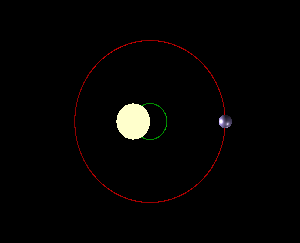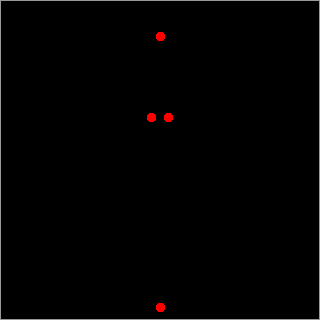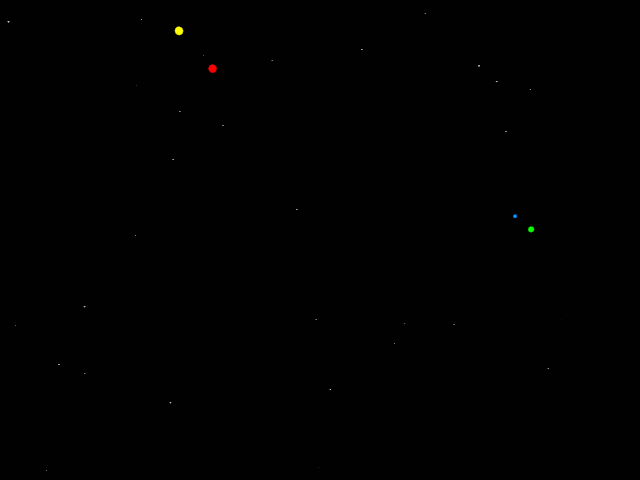Our Solar System ain't nothing once you've seen these: Multi-star systems and beyond!

Wrong. Kind of.
In the constant need to be in a state of rest, humans desire absolutes; answers in big red pen with a juicy full stop at the end. But the Universe doesn't care. The Universe has big plans that, for the most part, don't involve us.
Planets don't technically go around their stars, but rather the barycenter - the point usually deep inside of a star where both object's centre of mass lies.

To hammer this point home, Jupiter is so massive that its barycenter is actually outside of the sun, so in a very real sense, the Sun and Jupiter orbit each other.

But the Universe doesn't stop there. There is never going to be rest for your puny little mind.
I'm going to dig into some exceptions to the rules today, then discuss the potential of life in each case in part 2.
Rogue planets
Rogue planets are basically what they sound like. rather than orbit boring stars, they went for something bigger and decided to ditch their glowing mother and go for the Universe. Unfortunately, they end up orbiting the galaxy regardless, but still.
Nobody knows exactly how they get there, but it's likely that they were ejected from orbit via a large collision event, or simply never had the chance to gravitationally bind with another massive obejct, rather gaining mass the same way of stars but not even coming close to success. These can be called 'sub-brown dwarfs'.
7 light-years away, WISE 0855−0714 and 163 light-years away, Cha 110913-773444 were discovered floating around on their own. Yep, these are real things we've observed, no longer hypothetical.
Binary Planets

It's pretty lonely out there in the vastness of space. Why not bring a buddy along??
What you see here is '2MASS J1119−1137', or what scientists thought was a failed star, a brown dwarf, a star 10 times as massive as Jupiter but much smaller than any other star.
Wrong again! It turns out to actually be two gas giant planets, like jupiter orbiting each other. Both are about the same size as Jupiter, but each four times as massive so it's understandable that scientists would make that distinction error, given that they're 85 light years away in the darkness of space and all.
Planetstars...Starplanets... Plars? OTS 44
Way back in 1998, scientists discovered OTS 44, 550 light-years away with the Spitzer Space Telescope and the Herschel Space Observatory. This planet is special, at least to me. Using the infra-red spectrum, they saw that the planet has a circumstellar disk of dust, rock and ice.

This disk is huge. The planet itself is quite large, about 1.1% the mass of the sun, or 11.5 Jupiters, and the disk is about 10 earth-masses. Anybody who knows how solar systems form will know that over time, gravity causes these particles and rocks to coalesce into bigger and bigger chunks, each orbiting around the star as they slowly form into planets.
What I'm saying is that this large planet may in time become a miniature solar system, with up to ten rocky planets orbiting a large, gassy planet, all floating aimlessly in the depths of darkness.
This isn't just speculation. The Very Large Telescope (VLT) shows this coalescence happening at a rate of 10^−11 of the mass of the Sun per year. Imagine living there!
Jeeze.
Binary Star Systems
Ok I already touched on this in the previous episode, and most people know about these from Star Wars anyway. Still pretty cool though. Imagine two stars in the sky!
Binary star systems can work in different ways, however. For example, two stars could be orbiting each other while a planet far away orbits around both of them, or the planet could orbit just one of them close by, with the other star circling those two bodies.
But ok I get it, old news. How about this:
TRIPLE star systems

Yep. Again, not speculation.
149 light-years away, HD 188753 was discovered in the constellation Cygnus. With one main star about the same size as our own sun, and using the Keck telescope in Hawaii, a gas giant was observed orbiting every 3.5 days. The other two, smaller stars combined form a slightly larger mass than our sun, but are tightly orbiting each other, and so essentially serve as a single star, gravitationally speaking, about as far away as Saturn is to our Sun.
The formation of this planet is a deep mystery that doesn't really fit the models so far described. Typically, a hot jupiter so close to a star would have formed far away, gathering its deep atmosphere and so on, before migrating towards the star and getting it all stripped off again. But with two extra suns thrown into the mix, things become a little more... je ne sais quoi.
But ok fine, three stars, kinda cool. Nothing you wouldn't see in a modern PS4 game though. What about...
QUADRUPLE star systems
Oh yeah, I'm going there. This is some next level shit.
PH1 is a planet, about the size and mass of Neptune that orbits a pair of stars every 137 days. But far off in the distance, 900AU away (Astronomical Units - the distance between the centres of the Sun and Earth), another pair of stars were found orbiting around the centre 3 bodies. This combination was officially described as a 'circumbinary planet in a four-star system'.
Naturally, this can come in a range of combinations, PH1's is not the only way.

A second Quadruple star system was found, 30 Ari, 136 light-years away, only its formation looks even more complex. With the planet only orbiting one star, a second star orbiting those, and the second binary pair orbiting those.
Here's another weird combo.

But ok ok, you're a thrill seeker. 4 stars in the sky just doesn't quite do it for you. I have just the thing:
QUINTUPLE STAR SYSTEM??!!1j!
An estimated 4% of stars are in a quadruple system.
Pathetically common.
BUT, A mere 250 light-years away, a 5-star system exists, and is truly exotic.

Although no planet has been discovered just yet, there is no reason in the world of physics that a planet wouldn't be there somewhere. In fact, with scientists wondering if there are any stars without a planet nowadays, the chances are pretty high.
You might find this above image strange. Those infinity-looking stars are called 'contact stars', in which their orbits have gotten so close that their atmospheres are shared.
21 billion kilometers away you have another standard binary, but with a fifth star orbiting those.
The skyline on a planet would be unimaginable, though with constant daylight I'd probably have the curtains closed all day anyway. You can have too much of a good thing. And that's why I'm going to bring this article to a close.

So what have we learnt about the Universe?
- Planets can and do form pretty much anywhere. Give them the dust, and they will come
- Stars can form anywhere, too
- Our solar system is not even close to the only combination stellar bodies can have
- Planets can be stars (they can even be bigger than stars)
- Mini solar systems exist
- Star Wars lacks imagination
- Copernicus was dumb
And to think we're never, ever going to be able to visit most, if not all of it. Oh well.
Thanks for reading and please rate this article FIVE STARS
Couldn't resist.
Image Sources:
Jupiter Orbit
Binary Planets
Circumstellar disk
Triple Star System
Quadruple Star System
Quintuple Star System
Multi-star orbit pattern GIF
Planet getting tossed away
Water World
Eyeball Earth
Extreme Exoplanet Weather of Death and Doom
Planet as old as the Universe
For those of you who got to the bottom, here's an extra brain-boggling orbital formation for you, with grave consequences:

Mind... Blown! Thanks for the post
Undoubtedly a great post. If some kind of life form exists somewhere out there,in one of those multi star systems, it sure is going to enjoy truly gorgeous and exotic sunrises and sunsets!
Great article! So, would a planet in a multi-star system have "sun"-light all time of the "day" , as it orbits around the multiple stars?? No sleep for the wicked!
Seriously though, if it is like this, imagine all the different ways that nature & life might evolve... day/night cycle is so important for Earth's ecology, so a drastically different model would result in a drastically different environment.
The pessimist in me feels like they'd get sick of it lol. Thanks for reading!
thanks for taking the time to put up such a cool presentation... I have upvoted and following you also resteemed this so other people might notice it, also so I can study it later after I take my daughter to jr high orientation, thanks again... keep it up
Very much appreciated! This one took some time but it was excited for a nerd like me heh
Oh wow...I actually understood you and it was not boring! It is kinda scary isn't it? How small we are...a bit meaningless. How much MORE there is...
I'm not a real scientist so I have to use layman language cause it's all I am! Heh. But yeah I dunno, I never feel meaningless, I just think 'woahhhhh'
Very good my friend
amazing article, well written.
btw, there is also the castor system, newly discovered, six stars orbiting around center of mass :)
upvoted,resteemed, and i'll follow you to read more :)
Ahhhh no way, I only quickly glanced to see if I could find 6 but the article was long enough so I dismissed it hahaha,
Thanks a lot, appreciated
when the first images started coming in from the hubbell telescope, i knew the universe was going to turn out to be far weirder than anyone expected. i'm not sure there's ever going to be a unified theory of star system formation as we're discovering every day new and perplexing examples that don't fit neatly into any previous catagory. it's going to drive many cosmologists batty ;). thanx for your effort to explain some of our more exotic neighbors. keep 'em coming to help nourish my inner nerd
Yeah the Hubble Ultra Deep Field is insane to even try to fathom. So many exceptions to so many rules out there!
Glad you enjoyed the read
Upvoted by Physics-Trail!
I really enjoyed the article and learned new stuff :)
But what I enjoyed more was your writing. Copernicus... what an idiot!